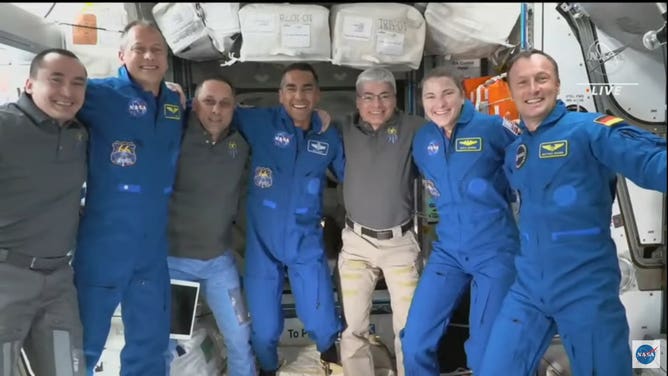Astronauts prepared for 'safe haven' as Russian satellite debris neared
Space station passes Russian satellite debris every 90 minutes.

NASA astronauts Raja Chari, Tom Marshburn, Kayla Barron, and ESA astronaut Matthias Maurer pose for a photo with NASA astronaut Mark Vande Hei and Russian cosmonauts Anton Shkaplerov and Pyotr Dubrov after arriving on space station on Nov. 11, 2021.
(NASA)
On the International Space Station, astronauts received an early wakeup Monday to prepare for "safe haven procedures" due to a Russian test that destroyed a satellite creating a large plume of space debris, audio from mission control to the space station shows.
NASA Astronaut Mark Vande Hei was the first to respond when mission control sent its first message something was wrong.
"Hey Mark, good morning, sorry for the early call. We were recently informed of a satellite breakup and need to have you guys start reviewing the safe haven procedure," mission control informed him.
The procedure meant closing some hatches, and the astronauts would be ready to depart in the SpaceX Dragon spacecraft if needed.
According to a statement from NASA, the crew closed the hatches to radial modules on the station, including Columbus, Kibo, the Permanent Multipurpose Module, Bigelow Expandable Activity Module and Quest Joint Airlock.
A little while later, the astronauts learned more information about the situation.
"Because of the nature of this satellite break up, we expect that we would see this risk every 90 minutes, and while the teams on the ground are analyzing this risk, we could see staying in this configuration with the radial hatches closed for up to a day," mission control told them, adding "it could be a little shorter" or longer than a day.
Russia destroyed one of its satellites in low-Earth orbit Monday during an Anti-Satellite (ASAT) test, creating approximately 1,500 pieces of space junk.
The International Space Station orbits the Earth every 90 minutes and, when doing so, would potentially pass through the debris cloud.
U.S. and European officials quickly condemned the act, calling it a "reckless and intentional generation" of space debris, saying Russia endangered its cosmonauts on the ISS.
About two hours into the event, mission control informed the astronauts, "we have passed the first time through the debris," adding there were "no sign of leaks" from a hit.
A short while later, before the next close approach, the crew was told to once again "activate safe haven in Dragon." According to mission control audio, the two Russian cosmonauts got into their Soyuz spacecraft for the debris pass.
According to NASA, the crew members made their way into the Dragon spacecraft before 2 a.m. EST and remained there for about two hours.
Two hours of communication with the astronauts and mission control show the crew appeared calm as they worked through the incident.
The Russian-created debris appears to be part of life on the International Space Station now, with updates every 90 minutes.
"Station, Houston on two. Debris field crossing complete," Mission Control told the crew Tuesday morning.
NASA Administrator Bill Nelson spoke with the head of Roscosmos Dmitry Rogozin on Tuesday by phone.
Rogozin provided a recap of the meeting in a tweet, saying in Russian, "we are moving on" and adding the two space agencies are working to ensure the safety of the astronauts on the ISS, and "building joint plans."
Later in the day, Nelson added his thoughts on the meeting.
Nelson wrote in a tweet he expressed his "dismay over the danger our astronauts and cosmonauts continue to face on the International Space Station. It’s critical that we ensure the safety of our people and assets in space – now and into the future."
Space junk is not a new issue for spaceflight. More than 30,000 pieces of space debris are being tracked by the Department of Defense's global Space Surveillance Network sensors. However, some trash is too small to be tracked.
As low-Earth orbit gets more populated, satellites have crashed into other objects in space, creating more space trash.
In 2009 an old Russian spacecraft hit a working satellite creating more than 2,300 pieces of large debris and many more pieces of smaller debris, according to NASA. Another anti-satellite test by China in 2007 used a missile to destroy a defunct satellite, creating more than 3,500 pieces of space trash.
According to NASA, these pieces of space trash are moving at 15,700 mph, and an impact of even the smallest amount of trash could create problems for the space station or a spacecraft.
Nelson told The Associated Press the astronauts "now face four times greater risk than normal" from space junk because of the Russian satellite debris.
A day after the event, U.S. allies, including the U.K., France and New Zealand, added their voices to condemn continued the Russian ASAT test.